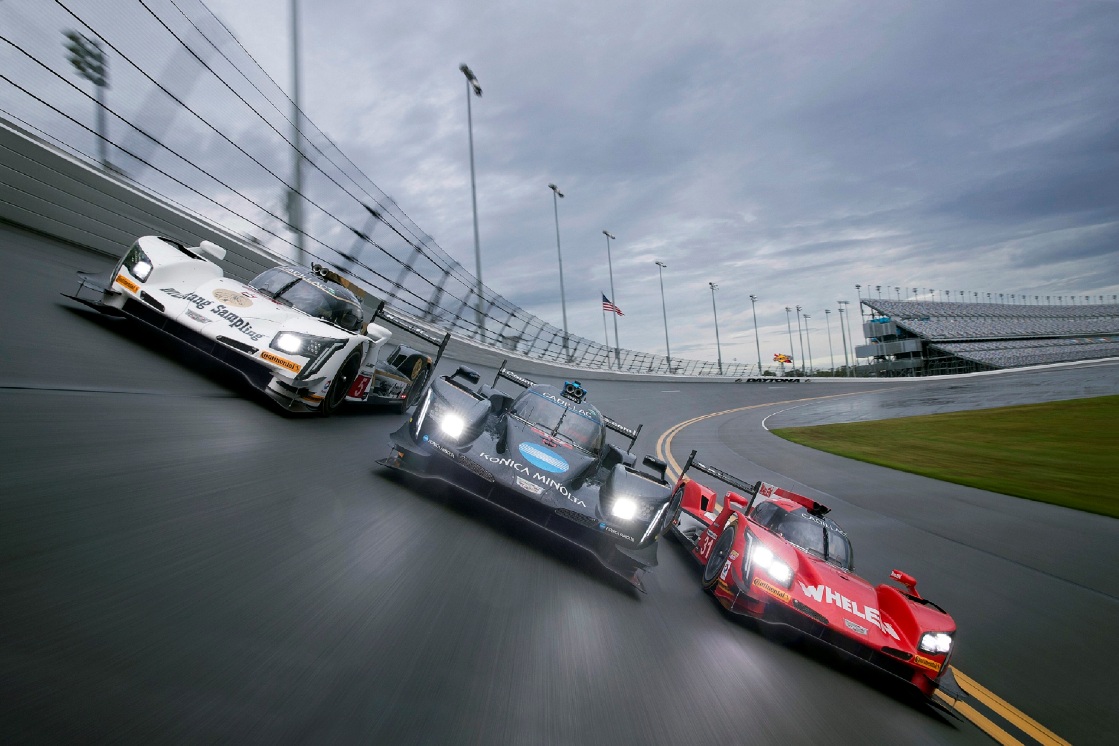
The Cadillac 6.2L V-8 Delivers Undefeated Performance
The Cadillac 6.2L V-8 engine has been consistent in delivering power and reliability to the three Cadillac prototype race cars: No. 10 Konica Minolta Cadillac DPi-V.R, No. 5 Mustang Sampling Cadillac DPi-V.R and No. 31 Whelen Engineering Cadillac DPi-V.R. Each team has only used two engines in competition, enabling the newest generation of Cadillac race cars to collectively cover more than 15,500 miles under IMSA sanction with near-flawless performance.
Inherent Architecture
The race-prepped Cadillac 6.2L V-8 engine, which shares original architecture with the Cadillac 6.2L V-8 engines in the Cadillac CTS-V super sedan and the Cadillac Escalade prestige SUV, is naturally aspirated and outputs near 600 hp at a maximum allowable 7,600 rpm with the series-mandated air restrictors in place. The race car engines are modified, built and maintained by ECR Engines.
“As in the Cadillac CTS-V and Escalade, the Cadillac 6.2L V-8 in the race car produces unrivaled, unfailing power and responsiveness,” said Richard Brekus, Cadillac Global Director of Product Strategy. “This season we exchanged engines only once for each car, each receiving a fresh engine after the Rolex 24 At Daytona. We disassembled the first engines and found no issues, problems or anomalies after the Rolex 24. The three cars have each run the engine we installed after the 24-hour race, taking the green flag on the first practice at Sebring, running and winning at Sebring, Long Beach, the Circuit of the Americas and Detroit with no major issues.”

In addition to providing lasting power, the Cadillac 6.2L V-8 is an integral part of the overall design of the Cadillac DPi-V.R prototype race car, and a key to the structural rigidity of the vehicle. As a semi-stressed member of the chassis, the engine takes some of the load delivered from the chassis, acting as the spine for the carbon fibre monocoque.
This design feature was on display during the 12-hour race at Sebring International Raceway, 3.74 miles of varied surface including cement that has survived since being used as a World War II runway. The pounding that a race car takes during the 12 Hours of Sebring is equivalent to what a race car endures during the 24 Hours of Le Mans. Also, the engine has to withstand the high-sweeping loads of Daytona’s banked speedway, the high lateral g-forces at Circuit of the Americas and the bumpy rides of the Long Beach and Detroit street courses with their surface changes, crowns and curbs.
Race-prepped Cadillac 6.2L V-8 Engine Facts:
- Each Cadillac V-Performance racing team in IMSA has only used two engines in competition, with the exchange taking place after the Rolex 24 At Daytona. Each team has used the same engine from Sebring through Belle Isle.
- All three Cadillac DPi-V.R engines that raced from Sebring through Belle Isle without issue have each travelled approximately 2,822 miles, or more than a trip from Cadillac House in New York City to Hollywood, California. This would also be more than the total distance of driving from London to Rome and then back to London.
- 2,822 miles is almost equivalent to 15 F1 races (F1 races average 190 miles per event).
- From Sebring through Belle Isle, the race-prepped engines were operated at the same fluid temperatures (water and oil) as that of the production engines in the Cadillac CTS-V super sedan and the Cadillac Escalade.
- From Sebring through Belle Isle, not a single oil change was performed, nor was an oil filter replaced.
- From Sebring through Belle Isle, each engine experienced a total of approximately 36,000 upshifts and downshifted events.
- From Sebring through Belle Isle, each engine experienced a total of more than 13 hours of wide-open throttle.
- Across the IMSA circuits, the engines repeatedly experienced as high as 3.5 g’s lateral, 2.0 g’s vertical and 3.5 g’s under braking. The SUPERMAN: Ride of Steel roller coaster at Six Flags America pulls just under 4 gs.

The 2017 Cadillac CTS-V super sedan is powered by a supercharged 6.2L V-8 high-performance engine SAE-certified at 640 horsepower (477 kW) and 630 lb-ft of torque (855 Nm). With more horsepower and torque than key competitors from Stuttgart and Munich, the CTS-V is capable of 0-60 performance in 3.7 seconds and a top speed of 200 mph.
Extra Cooling Content
The supercharged Cadillac 6.2L V-8 engine makes more power more efficiently than the previous Cadillac supercharged engine by employing a more efficient, more compact 1.7L supercharger and matching it with direct injection and Active Fuel Management (cylinder deactivation). The CTS-V has extra cooling content to handle the higher heat rejection and does not require any changes from the factory for consistent track capability. All Cadillac performance engines complete 24-hour endurance testing.
The 2017 Cadillac Escalade prestige SUV is powered by a naturally aspirated Cadillac 6.2L V-8 rated at an SAE-certified 420 horsepower (313 kW) and 460 lb-ft of torque (623 Nm). The Cadillac 6.2L features state-of-the-art technologies, including direct injection, Active Fuel Management (cylinder deactivation) and continuously variable valve timing, delivering confident power, a rewarding 22 mpg during freeway driving and 8,300-pound towing capacity.

Great engine’s specs….
What a great engine!